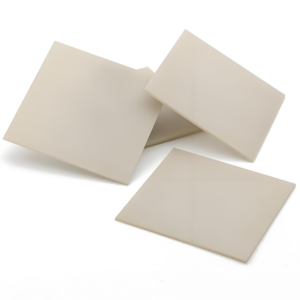Discover Premium Ceramic Products | Durability & Elegance United | Advanced Ceramics
1. Introduction
When it comes to high-temperature applications, few materials hold up like the silicon carbide crucible. Whether you’re melting metals, firing ceramics, or running industrial furnaces, this rugged ceramic component delivers unmatched thermal shock resistance and durability. But how does it stack up against other advanced ceramics like silicon nitride or boron carbide? And why is silicon carbide showing up not just in labs and foundries—but also in your kitchen as a silicon carbide ceramic baking dish or dinner plate?

In this article, we’ll break down the key differences between silicon carbide crucibles and their ceramic cousins, explore manufacturing variations like RBSiC (reaction-bonded silicon carbide), and clarify where alternatives might actually outperform this industrial workhorse.
2. What Makes Silicon Carbide Crucibles Unique?
Silicon carbide (SiC) is a compound of silicon and carbon with extraordinary hardness, thermal conductivity, and resistance to oxidation. A silicon carbide crucible leverages these traits to handle temperatures exceeding 1600°C without warping or cracking—critical for metal casting, glassmaking, and semiconductor processing.
Unlike traditional clay or graphite crucibles, SiC versions don’t absorb molten materials, reducing contamination. They also resist chemical corrosion from slags and fluxes, making them ideal for non-ferrous metal refining.
3. Silicon Carbide vs. Boron Carbide vs. Silicon Nitride
While all three are ultra-hard ceramics, their performance varies significantly in high-heat scenarios.
Boron carbide vs silicon carbide: Boron carbide (B4C) is harder and lighter, often used in armor and abrasives. However, it’s more brittle and less thermally conductive than SiC. For crucibles that undergo rapid heating and cooling, silicon carbide wins on toughness and thermal shock resistance.
Silicon nitride, on the other hand, offers excellent fracture toughness and is commonly used in bearings and cutting tools. A silicon nitride crucible factory might produce components for specialized aerospace applications, but silicon nitride generally can’t match SiC’s thermal conductivity or cost-effectiveness for large-scale melting operations.

That said, custom silicon nitride heat shields or silicon nitride rings excel in environments requiring high mechanical strength at moderate temperatures—just not the extreme thermal cycling where SiC dominates.
4. Types of Silicon Carbide Crucibles: RBSiC and Beyond
Not all silicon carbide crucibles are created equal. The two main manufacturing methods are:
- Reaction-bonded silicon carbide (RBSiC): Made by infiltrating porous carbon preforms with molten silicon. RBSiC silicon carbide tile blocks and crucibles offer near-net-shape precision and high purity, ideal for semiconductor and lab use.
- Sintered silicon carbide (SSiC): Densified at high temperatures without binders, yielding superior chemical resistance but at higher cost.
RBSiC is often preferred for complex shapes like silicon carbide ceramic columns or silicon carbide burner nozzles due to its dimensional stability. Meanwhile, sintered variants are used where maximum purity is non-negotiable—such as in the high purity silicon nitride powder market’s ancillary equipment.
5. Beyond Crucibles: The Everyday Rise of Silicon Carbide Ceramics
You might be surprised to learn that silicon carbide isn’t just for industry. Thanks to its non-toxic, non-porous surface and heat retention, it’s increasingly used in tableware.
Products like silicon carbide ceramic dinner plates, silicon carbide baking ceramic dish, and even silicon carbide ceramic butter dish with lid are gaining traction among chefs and home cooks. Brands like Staub have explored silicon carbide baking dish Staub lines for their oven-to-table versatility.

Other popular items include silicon carbide ceramic serving bowls, silicon carbide ceramic casserole dish with lid, and silicon carbide ceramic ramekins. Whether you prefer silicon carbide white ceramic plates or silicon carbide black ceramic plates, the aesthetic is sleek, and the performance is oven-safe up to 500°C.
6. Industrial Applications: Tubes, Discs, and Pipes
Silicon carbide’s utility extends far beyond crucibles and dinnerware. In industrial settings, you’ll find:
- Silicon carbide tubes for furnace use, including silicon carbide thermocouple protection tubes and silicon carbide ceramic tube for furnace linings.
- Silicon carbide discs and silicon carbide ceramic grinding disc variants used in precision machining and pottery finishing (e.g., silicon carbide diamond grinding disc for pottery).
- Silicon carbide ceramic pipes and silicon carbide ceramic plumbing pipe in corrosive fluid handling systems.
Even niche components like silicon carbide ceramic disc taps and silicon carbide ceramic disk for tap rely on SiC’s wear resistance and smooth surface finish.
For high-temperature gas flows, silicon carbide burner nozzles and silicon carbide brick linings ensure longevity where metals would fail.
7. Choosing the Right Material for Your Needs
So, should you go with a silicon carbide crucible or consider silicon nitride? Ask yourself:
- Do you need extreme thermal shock resistance? → Choose silicon carbide.
- Is chemical inertness at very high purity levels critical? → Consider sintered SiC or silicon nitride plate options.
- Are you designing consumer kitchenware? → Silicon carbide ceramic dishes for oven use offer unmatched durability and style.
While boron carbide may win in hardness, and silicon nitride in fracture toughness, silicon carbide remains the balanced champion for most high-heat, high-wear applications—both industrial and domestic.
8. Conclusion
From the foundry floor to your holiday table (yes, even silicon carbide christmas ceramic platter exists!), silicon carbide proves its versatility across sectors. Whether you’re comparing boron carbide vs silicon carbide for armor or selecting a silicon carbide ceramic casserole for Sunday dinner, understanding the material’s strengths ensures you pick the right ceramic for the job. As manufacturing advances and costs decrease, expect to see even more silicon carbide ceramic plates and bowls in both labs and kitchens worldwide.
Our Website founded on October 17, 2012, is a high-tech enterprise committed to the research and development, production, processing, sales and technical services of ceramic relative materials such as 7. Our products includes but not limited to Boron Carbide Ceramic Products, Boron Nitride Ceramic Products, Silicon Carbide Ceramic Products, Silicon Nitride Ceramic Products, Zirconium Dioxide Ceramic Products, etc. If you are interested, please feel free to contact us.

